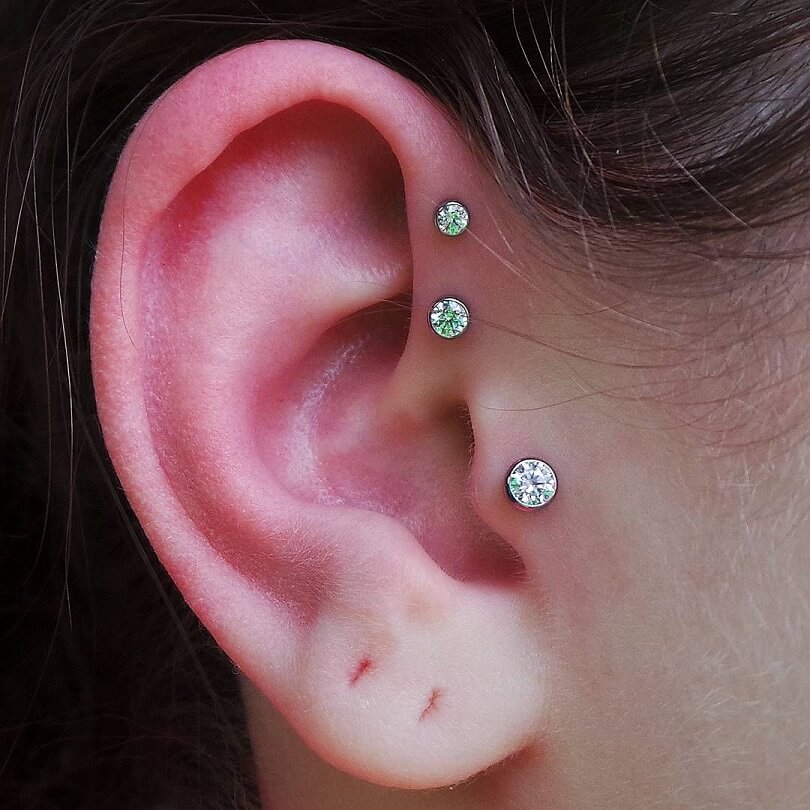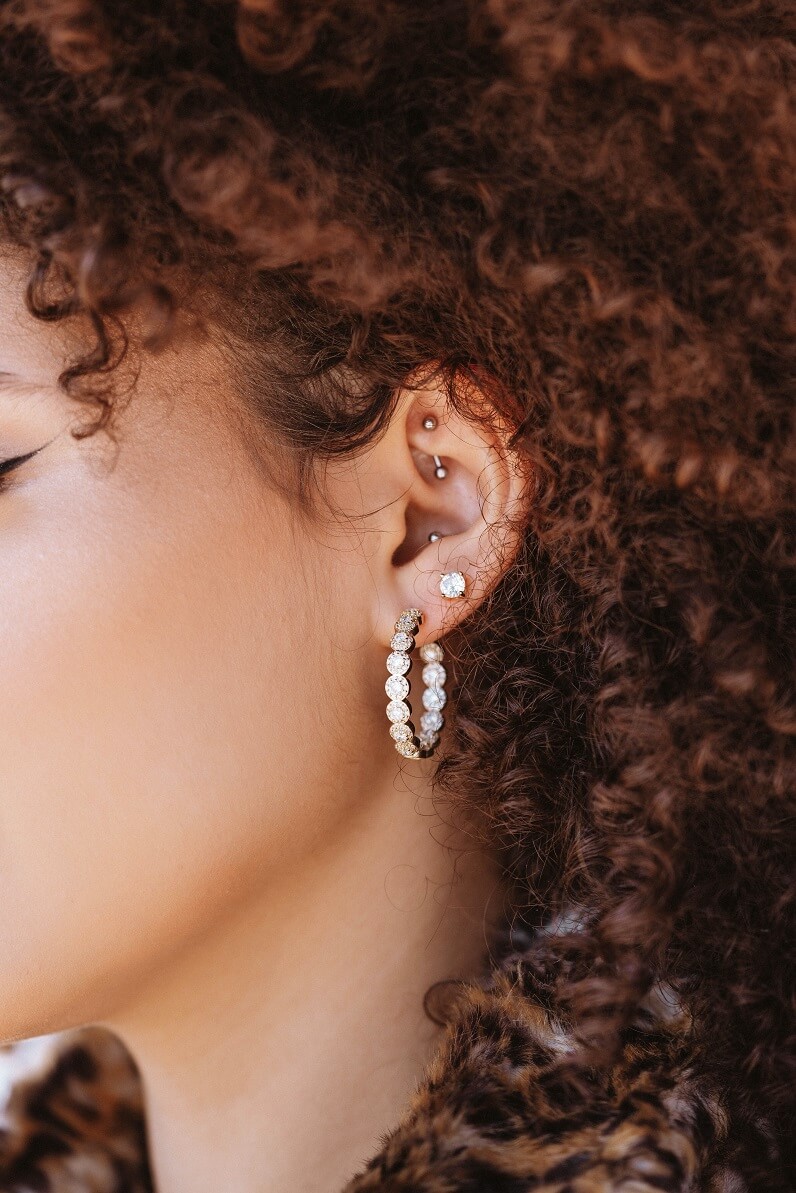There’s much more to ear piercings than the traditional lobe earring you got as a child. Daith, rook, conch, and helix may sound like car parts or sci-fi species, but they’re actually the names of parts of your ear that you can pierce.
The arrangement of ear piercings can be just as curated as any other element of your personal style. Here’s everything you need to know about preparing for an ear piercing appointment, from prep to placement and more. (Check out our nose and bellybutton piercing guides, too!)
Picking placement
With lots of ridges and folds, you can pierce pretty much anywhere on the ear. Ear piercing location choice is primarily about aesthetics, but other factors like pain tolerance, cost, and healing difficulty may sway your decision. It may help to think about the areas of your ear in three categories: your lobe, outer ear, and inner ear.
Lobe
The lower part of the ear that connects to your head is the lobe, and it’s the most common placement for ear piercings. The skin here is softer than the upper and inner areas of the ear. Not only does it have the most surface area, but it also tends to be the least painful spot to pierce and typically heals the fastest.
Many ear lobes can fit two to three piercings, so this is a perfect place to start if you’re interested in a stacked look with several earrings in a row.
- Pain level: Low
- Typical healing time: 2-3 months
- Typical average cost*: $25-$35 for 1 piercing + cost of earrings
Outer ear

There are several pierceable areas on the outer ear region, which is closest to the edge of the ear. This area is made up of cartilage and is harder to the touch than the lobe. Generally, piercing the cartilage tends to hurt more than the lobe because it puts up more resistance to needles. It can also take a bit longer to heal and is more prone to infection.
Tragus
Above the ear lobe and connected to the face is a triangular piece of cartilage called the tragus. This skin can be quite thick, making it one of the most painful places on your ear to pierce. The tragus doesn’t have a lot of surface area, but it can accommodate a stud or a small hoop.
- Pain level: High
- Typical healing time: 3-8 months
- Typical average cost*: $35-$50 for 1 piercing + cost of earring
Helix
The helix is the outermost edge of the ear that runs from the scalp around the lobe. A standard helix piercing is at the midway point of the outer ear, equidistant between the scalp-touching part and lobe-touching part of the helix.
A piercing at the area close to the scalp is known as a forward helix and is often done with a small hoop. An industrial piercing is when a long bar goes through the inner part of the ear, piercing both the forward helix and the standard helix areas. The flat helix area closest to the lobe is sometimes known as the auricle.
- Pain level: Medium to high
- Typical healing time: 6-12 months (industrial piercings may take up to 18 months)
- Typical average cost*: $35-$50 for 1 piercing + cost of earring
Inner ear

Similar to how the helix is the C-shaped edge of the ear, there’s a parallel C-shaped ridge on the inner ear with several piercing locations of different names: snug/anti-helix, rook, daith, conch, and anti-tragus.
Anti-helix/snug
The anti-helix, also called the snug, is located midway through the ear’s inner ridge. This skin tends to be even thicker than the helix and is often pierced with a curved bar or hoop.
- Pain level: Medium to high
- Typical healing time: 6-12 months
- Typical average cost*: $35-$50 for 1 piercing + cost of earring
Rook
The rook is the top part of the inner ear fold. Like the snug, this area is often pierced with a small ring or curved bar.
- Pain level: Medium
- Typical healing time: 6-12 months
- Typical average cost*: $35-$50 for 1 piercing + cost of earring
Daith
The daith connects the outer ear (helix) to the inner ear. If you run your finger along the outer edge of your ear toward the inner part, you’ll land at the daith.
- Pain level: Medium
- Typical healing time: 6-12 months
- Typical average cost*: $35-$50 for 1 piercing + cost of earring
Conch
Unlike the other parts of the inner ear mentioned, the conch isn’t located along a fold. Instead, it’s the inner cup part of the ear that’s often pierced with a stud or large ring.
- Pain level: Medium
- Typical healing time: 6-12 months
- Typical average cost*: $35-$50 for 1 piercing + cost of earring
Anti-tragus
The anti-tragus is a small area located atop the lobe. It feels and looks similar to the tragus, but it’s in the inner part of the ear rather than the outer part. Micro hoops and studs are often used on the anti-tragus.
- Pain level: Medium
- Typical healing time: 6-12 months.
- Typical average cost*: $35-$50 for 1 piercing + cost of earring
Preparing for your piercing

There are a few things you can do to ensure your piercing goes smoothly. First, pick a reputable piercing studio with lots of experience. As much fun as “The Parent Trap” made the old sleepover method look, it’s not a good idea. Not only can home piercings lead to infection, but the piercing itself will likely be much more painful.
Contrary to what might seem logical, piercing ears with a needle tends to cause less trauma and pain than piercing with a gun, so be sure to ask about the method when choosing a studio. Also, the earring you choose should be made from a high-quality material, such as 14-karat gold. Avoid low-quality metals like nickel, cobalt, and chromates because they’re likely to cause allergic reactions.
If you tend to get woozy at the sight of needles or blood, you’ll want to eat an hour or so before your piercing and drink lots of water before and after. And there’s no shame in shutting your eyes before the needle comes out!
Finally, don’t take ibuprofen beforehand. As tempting as it may be to get ahead of the pain, NSAIDs like ibuprofen or aspirin may increase bleeding because they’re blood thinners. To avoid excess bleeding, wait until your piercing is complete before taking any pain meds.
Ear piercings are personal
Believe it or not, almost every little fold on your ear has a name and can be pierced. The decision of where to pierce comes down to personal preference and pain tolerance. Whether you want to go for a classic lobe piercing or experiment with a trending look, choose a reputable piercer with plenty of experience, and always select an earring made of non-irritating metal.
*Costs are a rough estimate and depend on a variety of factors.





